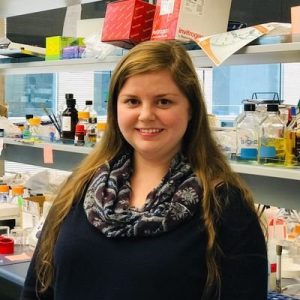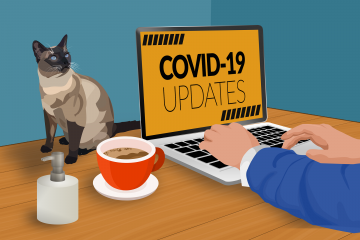 By Dr. Yanina-Yasmin Pesch, Postdoctoral Fellow, Tanentzapf Lab
By Dr. Yanina-Yasmin Pesch, Postdoctoral Fellow, Tanentzapf Lab

“What we know about COVID-19 is constantly evolving and new information is immediately and widely shared on the internet.”
Science can be a long and painful process; studies contradict each other and new evidence is gathered and hypotheses are made, just to be revoked by other studies. The COVID-19 pandemic is unique, because it marks the first time that the general public can see the scientific process unfold right before their eyes. What we know about COVID-19 is constantly evolving and new information is immediately and widely shared on the internet. SARS-CoV-2 research has progressed at warp speed and the sheer amount of information available through the internet and television can make it hard to navigate. As of March 2021 – exactly a year after widespread lockdowns slowed down the world, a PubMed search for COVID-19 yields over 100,000 hits1 – an incredible feat considering its novelty. The dense and fast-paced landscape of COVID-19 research could easily make anyone overwhelmed and confused. But as COVID-19 continues to pose a large threat to people’s lives and economies all around the world, it is crucial for new knowledge about the virus to be easily accessible to the public.
Scientists across the globe have made great efforts to distribute the facts around COVID-19 to the public. Whether it is articles, websites, podcasts, visualizations such as live dashboards indicating case counts, or YouTube videos – there’s no shortage of information about the pandemic out there. Public health officials such as Dr. Anthony Fauci and BC’s own Dr. Bonnie Henry have almost become celebrities, but there are limits to how far their messages can reach, as certain widespread phenomena threaten effective science communication in these difficult times and accelerate the spread of misinformation. One problem is that the media tends to declare every small development as a “breakthrough”. In addition, a biased approach of focusing on certain studies, while disregarding others with contradictory results, creates mixed messages as well as lots of disappointment. Issues of misinformation spread pose a great harm due to the potential to further damage people’s health. One example is the anti-malaria drug hydroxychloroquine, which was initially deemed a “miracle cure” for COVID-19, but was found to be ineffective in subsequent clinical trials2.
All-in-all, it is important that science communicators convey information in a way that is easy to understand for the general public, clearly state what’s fact and what’s fiction, and not rush to declare anything as a “miracle cure”… Clear messaging by scientists is more important than ever.
In addition, conspiracy theories pose a threat to science, which are often fueled by pseudo scientists with a large platform on social media (such as Youtube). These platforms and the messaging propagated through them have a lot of power because a part of their audience may lack the ability to spot pseudoscience and “fake news”. 3, 4
It often seems like scientists and public health officials are talking into a void. The reality is that during the pandemic, scientist often function as the bearer of bad news and risk being ignored. Public health measures can only be effective if the vast majority of people are following them. This is where science communication comes in: the public needs to understand why restrictions are important to curb viral spread. The more well-informed the public is, the more likely they are to follow the rules and opt for vaccination against COVID-19, and the faster we can get the pandemic under control.
All-in-all, it is important that science communicators convey information in a way that is easy to understand for the general public, clearly state what’s fact and what’s fiction, and not rush to declare anything as a “miracle cure”. Never before has a topic been collectively studied by scientists all around the world at such a rapid speed – revealing lots of new insights, but also causing mass confusion and contradictions, mostly fueled by pseudoscientists and influential people on the internet. Clear messaging by scientists is more important than ever.
References:
1 https://pubmed.ncbi.nlm.nih.gov/?term=covid-19
2 Pazzanese, C. Battling the ‘pandemic of misinformation’. Harvard Gazette. 2020 May 8. https://www.sciencedirect.com/science/article/pii/S0924857920300996?via%3Dihub
3 Gross, M. Communicating science in a crisis. Current Biology. 2020;30:R737-R739. https://www.cell.com/current-biology/pdf/S0960-9822(20)30904-0.pdf
4 Wambier CG. Hydroxychloroquine and azithromycin as a treatment of COVID-19: results of an open-label non-randomized clinical trial. International Journal of Antimicrobial Agents. 2021;57:106175-106175. https://news.harvard.edu/gazette/story/2020/05/social-media-used-to-spread-create-covid-19-falsehoods/


